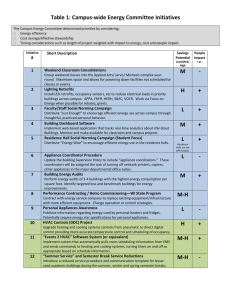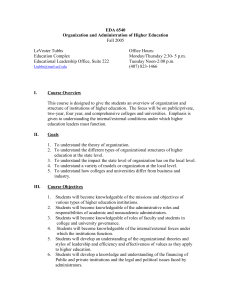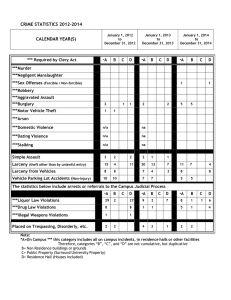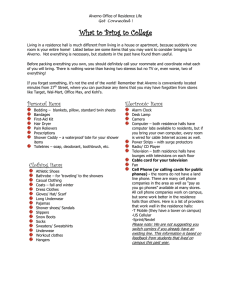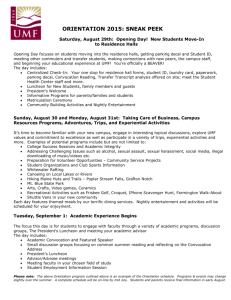RESIDENCE HALL RENEWAL PLAN UW–STOUT
advertisement
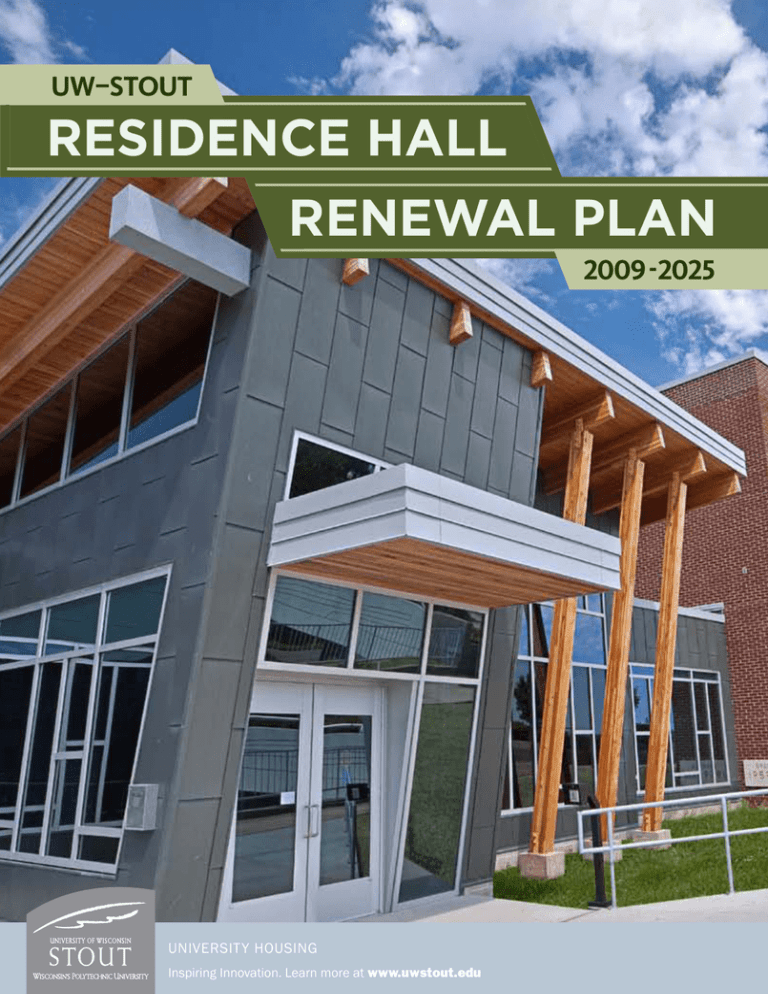
UW–STOUT RESIDENCE HALL RENEWAL PLAN 2009-2025 University Housing Inspiring Innovation. Learn more at www.uwstout.edu UNIVERSITY HOUSING OVERVIEW It’s time to redefine our standard! JETER HALL KITCHEN L iving on-campus has always been a valuable component of the UW-Stout college experience. Over the past four years, 95% of freshman students have lived on-campus along with a significant number of sophomores, juniors and seniors. The demand for housing has grown, as has the campus enrollment. University Housing is very focused on creating inclusive communities where all students feel welcomed and accepted. Our core community development model includes the concepts of Responsibility, Ownership, and Civility, or better known as R.O.C. We expect our students to take responsibility for their behaviors, to take ownership in their environment, and to treat each other civilly. In 2005, our department initiated a new structure to support student success. We created a First Year Experience program in the residence halls that placed first-year students in 6 residence halls on the main campus close to the core 1 of the academic, student service, and recreational facilities. We also developed programs to help students acclimate to the campus; become engaged with faculty, staff, and other students; learn what services are available to them; and hone their academic preparation skills. We begin by being more intrusive, and help students develop “incremental independence” as they navigate their way through college. For students in their second and subsequent years, we place them in one of our upperclass halls (primarily on the North campus) where we created the neXt eXperience (X2) program. The X2 program is designed to provide students with opportunities to develop proficiencies in areas such as conflict management, critical thinking, interpersonal communication, and life-long learning. Our intent is that when students leave the residence hall system, they will be better prepared for the challenges that adults face. BACKGROUND AND PLANNING PROCESS “Well-designed residence halls enhance physical and emotional well-being and create a sense of community that helps students thrive. Healthy residence include designated spaces where students can gather together to eat, talk, play or work. They incorporate circulation patterns and layouts that encourage interaction and allow easy transition between private and social areas. Whether it’s a fireplace hearth, a communal kitchen, or student and meeting rooms, social spaces offer students a sense of intimacy and promote social bonds and intellectual development.” In addition to providing a solid community development program for students, we recognize that we must also have facilities that meet their needs. In 2008, University Housing hired SDS Architects to analyze the UW-Stout residence halls and create a long-range infrastructure master plan to be used as a guide for renovation. The project was divided into two parts; an information gathering phase and a planning phase. During the informativon gathering phase, SDS reviewed previously developed materials, documented existing conditions through a facilities audit, and identified deficiencies. The planning phase involved identifying possible solutions to correct these deficiencies, developing a schedule and phasing options, and establishing budgets for the various solutions. Throughout the process, input was gathered from various campus stakeholders. In May 2009 the plan was presented to the campus for implementation and included both infrastructure upgrades as well as a redesign of the bathroom, stairwell, and community spaces on each floor to enhance the living-learning community. (Designing the Healthy Residence Hall: Strategies for ensuring healthy living-learning spaces, College Planning & Management magazine, October 2009) Our standard has been redefined! HOVLID HALL KITCHEN 2 Residence Hall Construction Dates: Antrim, Froggatt, Curran, Kranzusch, Tustison Hovlid (renovated spring, 2010) Tainter McCalmont North, South Red Cedar 1955 1958 1960 1962 1963 1965 1966 1967 1969 1970 Jeter, Callahan Hansen, Keith, Milnes Fleming 2005 Wigen Chinnock, Oetting The UW-Stout residence halls were all built between 1955 and 2005. Tainter Hall (1955), which is connected to Jeter (1958) and Callahan (1958), is slated to be razed after it is closed in the spring of 2012. The Tainter Dining Hall, which is attached to JTC, was abandoned as a dining facility in the fall of 2010 when the new North Point Dining and Fitness Center was built. North Point was part of a project that completely renovated Hovlid Hall and linked both Hovlid and Fleming Halls to it. A beautiful 24-hour fitness facility is located in the lower level of North Point. 3 HKMC GAME ROOM GUIDING PRINCIPLES FLEMING-HOVLID LOBBY The guiding principles used to develop this plan included the following: • Infrastructure upgrades should include plumbing, electrical, HVAC, telecommunication, windows, fire protection, door & hardware replacement, and roof replacement (when necessary) • Better accessibility for people with disabilities should be achieved • Students would like more privacy in the bathroom areas while maintaining community bathrooms • Each floor or cube should be able to accommodate men, women and transgender students • Minimize the loss of revenue-generating spaces • Maximize opportunities for community development • The cost must be reasonable and must be able to be absorbed into the fee structure • Maximum of approximately 240 beds can be taken off-line for remodeling at one time As the plan was created, it was divided into two components; how to proceed (phasing & scheduling) and how to correct the deficiencies (solutions). 4 PHASING AND SCHEDULING SOUTH HALL FIREPLACE LOUNGE S 6 5 everal options were developed, and one of these emerged as best meeting our overall needs, schedule and budget. The first option involved first constructing a new residence hall and then upgrading the existing buildings, but was eventually eliminated due to space and budget constraints. The second option was an accelerated plan that renovated two phases per year, and this was eliminated due to loss of revenue and the need to increase room rates too rapidly. The plan that was most appealing, which is referred to as the Spring/ Spring option due to the timing of the renovations taking place primarily during the spring semesters, was adopted. Given the layout of our buildings and the campus, a logical phasing of the projects surfaced. Since Hovlid Hall was our first major renovation and was done in the spring of 2010, it made sense to continue to work on the North campus before moving to the South campus. In addition, some monies had already been allocated for the North Campus which resulted in Wigen Hall being split into an early and late phase. When moving to the South campus, all buildings need updating, and we phased them according to need. Each cluster of buildings will be remodeled during two consecutive years, thus creating efficiency. For example, Curran-Kranzusch would be renovated during the spring & summer of 2018, and Tustison-Oetting would be renovated during the spring & summer of 2019. out with the drab... SOUTH HALL FIREPLACE LOUNGE in with the fab! 7 HKMC BASEMENT 6 SOLUTIONS UW-Stout residence halls were built with relatively low ceiling heights and with a cast-in-place floor slab structural system which does not allow for easy penetration. That, coupled with the need to minimize revenue loss, helped guide us to the conclusion that the bathrooms should be located in a small addition to each building where these factors could be best managed. Our residence halls have three basic building floor plans: cubes, rectangles, and linear. • Cubes have multiple square wings linked by corridor/lounge spaces. Residence halls of this type include CKTO, HKMC, and AF. • Rectangles are similar in structure to cubes, but are not equal on all four sides. Buildings of this type are North Hall and South Hall. • Linear buildings resemble boxcars – a single corridor down the middle with rooms on both sides and across from each other. Red Cedar, Wigen, Hovlid, Fleming and McCalmont Halls all are linear buildings. RED CEDAR FLOOR LOUNGE RED CEDAR HALL In the cube style buildings, the area that is currently the bathroom and stairwell will become the new community gathering space, complete with a floor kitchen, dining/work space, and a comfortable lounge area. Walls will be removed and replaced with doorways and windows/glass to provide access and visibility into the space. The blue areas on this diagram show the sections that will become community gathering spaces. The green areas are the new bathroom/stairwell additions. In the linear style buildings, the area that is currently the bathroom will become the new community gathering space, complete with a floor kitchen, dining/work space, and a comfortable lounge area. Walls will be removed and replaced with doorways and windows/glass to provide access and visibility into the space. The blue area on the top of this diagram shows the area that will become the community gathering space. The blue/green area on the botton is the new bathroom (the green area would be the addition). In these buildings, several of the stairwells are already on the outside of the building and do not need to be relocated. In the rectangular style buildings, the area that is currently the bathroom will become the new community gathering space, complete with a floor kitchen, dining/work space, and a comfortable lounge area. Walls will be removed and replaced with doorways and windows/glass to provide access and visibility into the space. The blue area in the middle of this diagram shows the area that will become the community gathering space. The green area is the new bathroom addition. In these buildings, several of the stairwells are already on the outside of the building and do not need to be relocated. 8 PROPOSED COMMUNITY GATHERING ROOM HOVLID HALL BASEMENT KITCHEN AFM BASEMENT 9 Gathering area floor plans S hown here are examples of what a typical community gathering space might look like in the cube buildings. By providing this space in the central part of the floor, it becomes the “living room/ dining room/kitchen” for people living in that community. Maximizing the glass walls to make it transparent will draw students in and make it become the “see and be seen” space that students enjoy while also reducing noise from conversations, media equipment, etc. The kitchen will help draw students into the space and is a high on student’s list of desires. The dining/work space is perfect for group projects or to have a late night snack. The media center (television, gaming equipment, etc.) will assist in building and strengthening the community and will provide a casual place for students to talk and relax. Dining/ Project tables Media Center Group Study Area Kitchen 10 COSTS & EFFICIENCY SOUTH HALL MEETING ROOM The residence hall renewal project is estimated to cost approximately $100,000,000. However, the cost to replace these buildings would be significantly more. In addition, it is more sustainable to reuse buildings than it is to tear them down and build new ones. Here is a breakdown of the estimated costs, per building: 2011 ........ Wigen Round 1 ................................................... $2,120,000 2012 ........ Fleming .............................................................. $6,370,00 2014 ........ North A/B .......................................................... $8,820,00 2015 ........ North C ............................................................... $4,430,000 2016 ........ South A/B .......................................................... $9,550,000 2017 ........ South C ............................................................... $4,560,000 2018 ........ Curran-Kranzusch ............................................ $9,830,000 2019 ........ Tustison-Oetting .............................................. $9,330,000 2020 ....... Antrim Froggatt ............................................... $10,800,000 2021 ........ McCalmont ........................................................ $6,540,000 2022 ........ Hansen-Keith .................................................... $11,390,000 2023 ........ Milnes-Chinnock ............................................. $11,030,000 2024 ........ Wigen Round 2 ................................................ $6,220,000 This plan will be paid for with student room fees. No state tax-payer dollars are used in the construction, renovation, or maintenance of any University Housing buildings or programs. Remodeling these buildings and replacing outdated windows, heating systems, mechanical systems, plumbing and electricity will result in substantial energy savings. In today’s dollars, the department will save an estimated $127,000 per year when the entire project is complete, or over $5,000,000 over the next 40 years. 11 SCHEDULE SOUTH HALL STUDY LOUNGE 2009 - 2011 2011 - 2013 2013 - 2015 2015 - 2017 Wigen, 1st Phase Fleming Hall North Hall South Hall 2017 - 2019 2019 - 2021 2021 - 2023 2023 - 2025 CKTO AFM HKMC Wigen, 2nd Phase HKMC BASEMENT LOUNGE HKMC BASEMENT 13 HOVLID HALL BATHROOM Main Campus Harvey Hall Fryklund Hall Bowman Hall Sports and Fitness Center (Johnson Fieldhouse) Vocational Rehabilitation 7 Child and Family 8 Study Center 10 Heritage Hall Millennium Hall 11 12 Robert S. Swanson Learning Center 15 Jarvis Hall – Science Wing Addition 16 Jarvis Hall – Science Wing 16A Jarvis Hall – Technology Wing 17 Micheels Hall 18 Administration Building 19 Applied Arts 36 Heating Plant 45 Memorial Student Center 46 Communication Technologies 47 Merle M. Price Commons 48 Student Health Center 1 2 3 5 61 61A 61B 62 63 64 65 65A 66 67 67A 67B 68 68A 68B 68C 69 69A 69B 69C 72 73 78 85 86 87 89 91 92 Tainter Hall Jeter Hall Callahan Hall Louis Smith Tainter House Red Cedar Hall Wigen Hall Hovlid Hall North Point Dining and Fitness Ctr. Fleming Hall McCalmont Hall Antrim Hall Froggatt Hall Hansen Hall Keith Hall Milnes Hall Chinnock Hall Curran Hall Kranzusch Hall Tustison Hall Oetting Hall North Hall South Hall Adventure Challenge Course Don and Nona Williams Stadium Burton Nelson Field Alumni Field General Services Building University Services Building Baseball Field North Campus CAMPUS MAP 14 HKMC KITCHEN SOUTH HALL RED CEDAR LOBBY This brochure was designed by Calvin Keyes, a senior from Green Bay, WI majoring in Multimedia Design, and the Housing Design Team. Photography provided by Colin Schye, a senior from Eau Claire, WI also majoring in Multimedia Design. July 2011 COVER: FLEMING-HOVLID ENTRANCE
